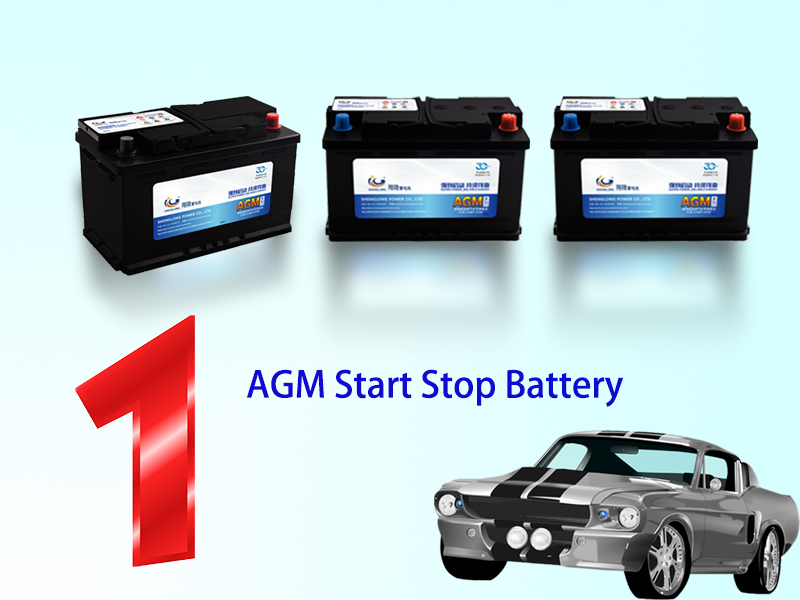In the realm of modern automotive technology, the AGM Start Stop Battery has emerged as a crucial component, especially for vehicles equipped with start-stop systems. Among the various types, 12V AGM car batteries are the most commonly used, playing a pivotal role in ensuring the seamless operation of a car’s electrical systems and engine startups. This article will take you on a detailed journey, exploring the working principles, advantages, and maintenance tips of these essential automotive power sources.
Understanding AGM Start Stop Battery
An AGM Start Stop Battery is a valve-regulated lead-acid battery that uses a fiberglass mat saturated with an electrolyte solution. Unlike traditional flooded batteries, the electrolyte in AGM batteries is immobilized, preventing spillage and evaporation. This design makes them more resistant to vibration, extreme temperatures, and physical shocks, which are common in automotive environments.
The “start-stop” in its name refers to its compatibility with vehicle start-stop systems. These systems automatically turn off the engine when the vehicle comes to a halt, such as at traffic lights or in heavy traffic, to reduce fuel consumption and emissions. When the driver releases the brake or presses the accelerator, the engine restarts promptly. An AGM Start Stop Battery is specifically engineered to handle the frequent charging and discharging cycles associated with these start-stop operations, ensuring reliable engine startups every time.

The Working Principles of 12V AGM Car Batteries
At the heart of 12V AGM car batteries lies a series of chemical reactions that convert chemical energy into electrical energy and vice versa. Inside the battery, there are positive and negative plates submerged in the electrolyte solution within the fiberglass mats. The positive plates are made of lead dioxide, while the negative plates are made of pure lead.
During the discharge process, when the car’s electrical systems draw power, a chemical reaction occurs between the lead dioxide on the positive plates, the pure lead on the negative plates, and the sulfuric acid in the electrolyte. This reaction releases electrons, creating an electric current that powers the vehicle’s starter motor, lights, radio, and other electrical components.
When the vehicle’s alternator charges the battery, the reverse chemical reaction takes place. The electrical energy from the alternator converts the lead sulfate formed on the plates during discharge back into lead dioxide and pure lead, replenishing the battery’s charge. The unique AGM design allows for efficient ion transfer between the plates, enabling faster charging and better overall performance compared to conventional batteries.
Advantages of AGM Batteries for Car Start-Stop Systems
AGM batteries offer several significant advantages when used as car start-stop batteries. Firstly, their high cycling capabilities make them ideal for start-stop applications. They can endure thousands of charge-discharge cycles without significant performance degradation, ensuring that the engine can be restarted reliably numerous times during a single journey.
Secondly, AGM batteries have a much lower self-discharge rate than traditional batteries. This means that they can retain their charge for longer periods when the vehicle is not in use, reducing the likelihood of a dead battery. Additionally, their superior resistance to vibration and shock makes them suitable for a wide range of driving conditions, from smooth city roads to bumpy off-road terrains.
Another key benefit is their high power output. AGM batteries can deliver a large amount of current instantly, which is essential for quickly starting the engine in start-stop systems. This rapid power delivery also ensures stable performance of the vehicle’s electrical accessories, even when the engine is repeatedly turned on and off.
Maintenance Tips for AGM Batteries
To ensure the longevity and optimal performance of your AGM Start Stop Battery or 12V AGM car batteries, proper maintenance is essential. Firstly, regular inspection is crucial. Check the battery’s terminals for signs of corrosion, such as white or green deposits. If corrosion is present, clean the terminals using a mixture of baking soda and water, and then apply a thin layer of petroleum jelly or a specialized terminal protector to prevent future corrosion.
Secondly, keep an eye on the battery’s charge level. Although AGM batteries have a low self-discharge rate, it’s still a good practice to use a battery charger or a trickle charger if the vehicle will be idle for an extended period. This helps maintain the battery’s charge and prevents sulfation, a process where lead sulfate crystals build up on the battery plates, reducing its capacity.
It’s also important to avoid over-discharging the battery. Don’t leave electrical accessories running for long periods when the engine is off, as this can drain the battery quickly. If the battery does become deeply discharged, recharge it as soon as possible to prevent permanent damage.
In conclusion, AGM Start Stop Batteries and 12V AGM car batteries are indispensable components for modern vehicles with start-stop systems. Understanding their working principles, advantages, and proper maintenance techniques can help you get the most out of your car start-stop battery, ensuring reliable performance and a longer lifespan. By following these guidelines, you can keep your vehicle’s power source in top condition and enjoy a smooth driving experience for years to come.
